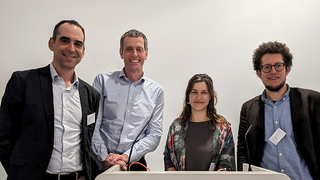University of Massachusetts Amherst: Reich Co-organizes Pair Of Scientific Meetings Of The Royal Society
Professor of biostatistics Nicholas Reich served as co-organizer of a pair of scientific meetings held in March 2023 by The Royal Society. The Royal Society is the independent scientific academy of the UK, dedicated to promoting excellence in science for the benefit of humanity. It is the oldest scientific academy in continuous existence.
Along with colleagues from Spain and the United Kingdom, Reich co-organized “Forecasting natural and social systems” (held March 13-14) and “Forecasting infectious disease incidence for public health” (held March 15-16). In the works since 2018 and originally scheduled for early 2020, the meetings took on a greater significance in a post-pandemic world.
“The Royal Society hosts multiple scientific meetings like this every year, and there is a competitive application process,” says Reich. “The organizing team members are all scientists who have worked in infectious disease modeling and forecasting, and we thought that it would be a great opportunity for researchers who work on forecasting in different disciplines to come together and identify areas of commonality in their work.”
“Forecasting natural and social systems” addressed the many different methodologies used to develop different types of forecasts, most of which are often developed in isolation within respective disciplines. The meeting convened leading experts in forecasting across disciplines to discuss the predictability of different systems, to exchange expertise, and to identify common challenges and possible solutions.
Professor of biostatistics Leontine Alkema served as one of the meeting’s featured speakers. In her talk “Forecasting in demography,” Alkema introduced the use of Bayesian statistical modeling approaches with examples in the area of family planning, reproductive health, and fertility. She presented general modeling challenges for producing nowcasts and forecasts, and common features of Bayesian statistical models that overcome these challenges. She ended with some comments related to ongoing and future research in statistical demography to improve the quality and utility of model-based nowcasts and forecasts.
“Forecasting infectious disease incidence for public health” addressed how forecasts have increasingly become the focus in analyzing and modeling infectious disease dynamics. The meeting discussed the latest developments in this area and identify cross-cutting areas and synergies with other fields.
Research assistant professor in biostatistics Evan Ray was among the meeting’s featured speakers. In a talk titled “Evaluating forecasts in the context of public health decision making,” Ray discussed how different forecasting scenarios – such as the peak transmission or peak hospitalization periods – can influence decisions regarding the allocation of limited resources to multiple jurisdictions. He explored a scoring rule he has developed that formalizes a measure of the value of a forecast in the context of this decision-making problem, as determined by the costs that would be incurred through misallocation if the forecast were used to set allocation levels. In his presentation, Ray explored how this scoring rule is related to the Weighted Interval Score (WIS) and illustrated how it could be used to evaluate forecasts from the US COVID-19 Forecast Hub.
“It was fascinating to hear from scientists who work on forecasting weather, earthquakes, demographic trends, ecology, climate patterns, societal conflict, and so much more,” says Reich. “There was a lot of common ground in how researchers approach the problems. A lot of fields combine forecasts from multiple models, as we have been doing in outbreak forecasting for over five years now, to improve accuracy. It was also interesting to hear about how many fields strike a balance between using machine learning to find patterns in data, often coupled with models informed by theory for the field in question, like models of atmospheric dynamics for weather, or contagion for outbreaks.”

